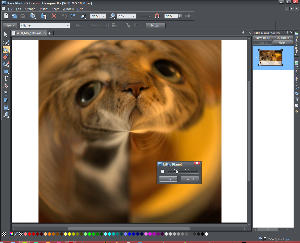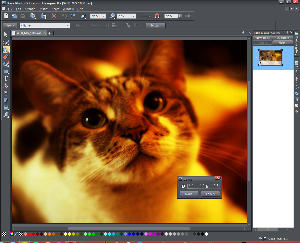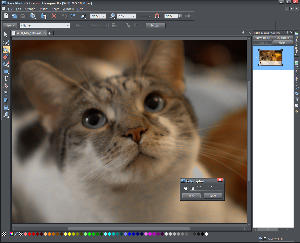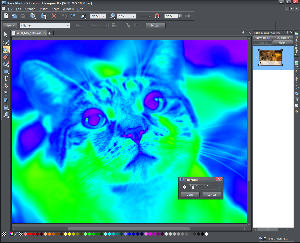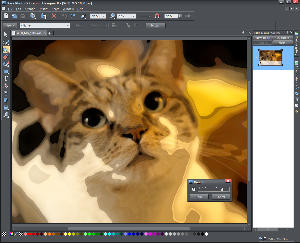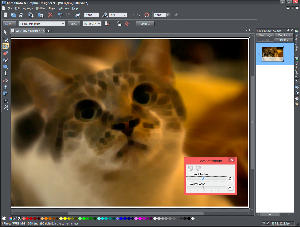Xara Photo and Graphic Designer Hits an In-the-Park Home Run
Xara's graphic design software has been trying to develop a following in the Unites States for decades by creating an application that can be used to create and edit both vector images (think Adobe Illustrator or Corel Draw) and pixel-based images (think Adobe Photoshop and Paint Shop Pro). Despite a surprisingly low price, Xara Photo and Graphic Designer 9 offers a lot of powerful features.
Xara uses an interface that could be called quirky because it doesn't look like any competing product's interface. Once you figure it out, though, it makes sense and it makes the program faster to use than most of its competitors.
The ability to handle both photos and vectors is a real plus for users, but it also makes the application difficult for reviewers to place in relation to other products. As a result of that, Xara Photo and Graphic Designer sometimes is overlooked.
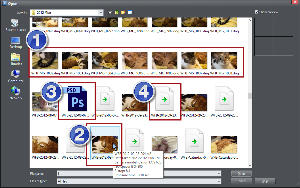 Consider the versatility. Xara Photo and Graphic Designer can open the files you have. You would expect to be able to open JPG and PNG files, and you can. TIFF files, too. But what about raw files such as CR2 or digital negative files (DNG). Yes! And what about Photoshop (PSD) files?
Consider the versatility. Xara Photo and Graphic Designer can open the files you have. You would expect to be able to open JPG and PNG files, and you can. TIFF files, too. But what about raw files such as CR2 or digital negative files (DNG). Yes! And what about Photoshop (PSD) files?
- CR2 raw files (Canon's format). Xara opens them.
- DNG files (converted by Adobe Camera Raw). Xara opens them.
- Photoshop files. There's no preview, but Xara opens them.
- Sidecar files (XMP). These won't open, but they're not supposed to; they're just used by Adobe Camera Raw to store information about the DNG file processing.
And the list goes on and on. EPS, BMP, GIF, CDR, PCX, TGA .... if you have a graphic file, either bitmap or vector, there's a good chance that this application will be able to open it.
What's New
From about version 7, Xara's primary emphasis on each new version has been on the photographic side. Version 9 offers Photo Heal (like Photoshop's Content-Aware Fill). Paint over the area that you want to remove and and the application tries to figure out what could plausibly appear there. This feature still needs some work but Magic Erase performs a similar task and, because it's been around since version 7, it's usually more reliable.
Version 9 offers 11 new photo effects, including sepia toning, filters that apply a grunge look, and one that applies a high-dynamic-range (HDR) look to images. You may also enjoy playing with the "Little Planet" effect that turns your photo into a sphere that appears to be hanging in space.
Unlike filters from companies such as Alien Skin, the Xara filters have only a single slider to control the effect. For a basic on/off filter such as sepia toning, that's all you need, but this seems a bit skimpy with HDR or Little Planet. These new filters are definitely not the most important new feature, but they're undoubtedly the most fun. Some examples ...
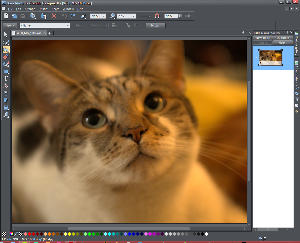 The starting point: Chloe Cat.
The starting point: Chloe Cat.
This is the cat who knows that she is entirely too cute for me, but hangs around anyway. It's an average snapshot image, although a high-resolution one and the file is a CR2 (raw) file.
This is definitely not a flattering look for kitty and she appears not to be enjoying it. As much fun as this is to play with, I haven't yet found an image that really works with it.
Probably in the next version of the application, or the one after that, there will be additional controls that will allow the user to place the point of inflection and possibly to make other modifications. This is a good example of a feature that needs more than one control.
Here's the look that make the picture look like it was taken with a 1968 camera that had a plastic lens.
The grunge look can be a lot of fun to play with and the single slider control is probably adequate for this one.
This is an effect that allows the user to modify specific colors within the image. In this case, I've reduced the yellow that was a result of using daylight color balance under tungsten lights.
If you like the effect that's created by converting a color image to monochrome and leaving one color intact, this is the tool that does it and it's a good example of a situation in which multiple controls would be helpful. A single slider selects the color you want to retain, but an accuracy slider (to widen or narrow the range of selected colors) as well as a feather slider (to blend the effect into the existing image) would be helpful.
Or you remember the 1960s, don't you?
Thermal imaging modifies colors depending on the physical temperature of what's being photographed. Or you can use it to create really amazing colors.
What good is an image like this?
Maybe no good at all. Or maybe it's just what you're looking for to make a point.
That's the thing about artistic endeavors: Art isn't intended to be pleasing. It's intended to make us think. So if you find an image that works well with this filter's approach, go for it!
I've saved a couple of impressionistic effects for last and both of these work for me with this image.
Sometimes you can tell more about a subject when less detail is present.
This effect allows modifications on both the horizontal and vertical axes. The result can range anywhere from barely visible to far overboard.
Here I think I have it just about right for a pointillist-type effect.
Better Typeface Support
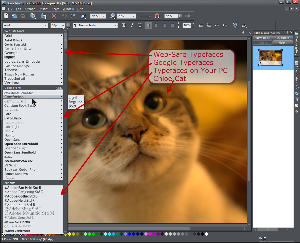 Typeface support is improved by adding access to the Google Font Library. Xara Photo and Graphic Designer can browse, preview, and install more than 600 typefaces included in Google Fonts.
Typeface support is improved by adding access to the Google Font Library. Xara Photo and Graphic Designer can browse, preview, and install more than 600 typefaces included in Google Fonts.
Photo and Graphics Designer 9 also includes an easier method to change colors in elements that have been constructed from many parts. Just drop a new color color onto the group and tell the application which color it's intended to replace.
It's now possible to apply color corrections to limited areas of a photograph by first painting on a mask (or by using the lasso tool or the marquee tool). Once you've created the mask, you can resize it if you didn't get it quite right the first time. Just grab the vector handles and modify the shape until it's the way you want it to be. These masks may be used to adjust brightness, contrast, saturation, color temperature, and hue.
Applying these masks to vector drawings may surprise you because they don't behave the way they would in most vector applications. The mask becomes a vector object and applies its modifications to everything that's below it.
Vector Images
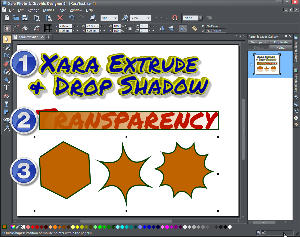 I'm not going to spend a lot of time on the program's vector capabilities because they're generally well known and Xara has been known for years (decades would not be much of an exaggeration) as the fastest vector art application on the planet. In that regard, nothing has changed.
I'm not going to spend a lot of time on the program's vector capabilities because they're generally well known and Xara has been known for years (decades would not be much of an exaggeration) as the fastest vector art application on the planet. In that regard, nothing has changed.
Xara Photo and Graphic Designer Vector Example
Here are 3 examples of Xara's capabilities.
- The 3D extrusion is better than anything Adobe Illustrator can create, but Illustrator users have never had acceptable bevel and extrusion capabilities. This is simply some text with a blue fill and a yellow border. I've applied a 3D effect to it and added a drop shadow. The complete process took about a minute. Oh—that's one of the Google typefaces, too.
- Here we have text behind a box that's filled with a color. The color is nearly opaque on the left and transparent on the right.
- Each of these images is the same Quick Shape. For the shape in the middle, I modified the lines between the points from the shape on the left. For the shape on the right, I added more points to the shape in the middle. Easy.

 This is the Graphics Application that Tries to Do Everything and Doesn't Fail at Anything
This is the Graphics Application that Tries to Do Everything and Doesn't Fail at Anything
Xara Photo and Graphic Designer v9 doesn't have all the power of Adobe Illustrator or all the features of Adobe Photoshop, so it can't always do what those large and expensive applications do, but its ability to handle both Illustrator-like vectors and Photoshop-like illustrations, particularly when combined with its price, makes the application an appealing choice for those who need to work with both media types.
For more information, visit the Xara website.
Farewell to AltaVista
Books were written about the revolutionary AltaVista when it debuted back in 1995. But success begets competition and one of the competitors was a little upstart named Google. Now, for AltaVista, after many years of irrelevance, it's the end of the line.
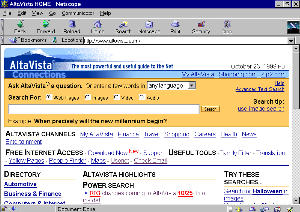 AltaVista was invented by the Digital Equipment Corporation (DEC), a maker of mid-range computers, that preceded AltaVista in death. DEC (aka "Digital") was once second only to IBM and its minicomputers were the most popular of the type, but the company's down-hill trajectory started in 1992 and in 1998, what remained of the company was sold to Compaq, which was eventually acquired by HP.
AltaVista was invented by the Digital Equipment Corporation (DEC), a maker of mid-range computers, that preceded AltaVista in death. DEC (aka "Digital") was once second only to IBM and its minicomputers were the most popular of the type, but the company's down-hill trajectory started in 1992 and in 1998, what remained of the company was sold to Compaq, which was eventually acquired by HP.
AltaVista in 1999
Although other pre-Web search functions existed, AltaVista was the first big search engine on the Web. After the rise of Google, Yahoo acquired AltaVista. In a typical Yahoo move, the company retained the name but funneled all searches to its own search engine.
On Monday, July 8, the AltaVista name goes away, changing exactly nothing. But ignoring this was not something that I could do because AltaVista was such an important part of the Web's early successes. DEC even made versions of AltaVista available for installation on PCs to provide the same kind of search functionality for users' locally-stored files.
Other search functions were available when AltaVista launched, but DEC's new offering had a fast, multi-threaded website crawler known as Scooter that could index more sites than were believed to exist at the time. The number of sites has increased substantially since then, of course.
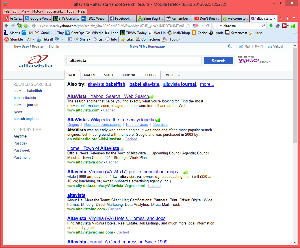 AltaVista processed about 2.5 million search requests per day in 1995, an unheard of number at the time. Compare that to the number of search requests that Google sees every day now: More than 5 billion.
AltaVista processed about 2.5 million search requests per day in 1995, an unheard of number at the time. Compare that to the number of search requests that Google sees every day now: More than 5 billion.
When Google came along in 1998, it quickly became the largest and most popular search engine ever known and, despite efforts by Microsoft and others, little has happened to change that in the intervening 15 years.
AltaVista (Yahoo with the AltaVista nameplate) today.
AltaVista had hoped to raise $300 million in an initial public offering (IPO) that was scheduled for December of 1999, but by that time the Internet bubble had begun to implode. As late as 2002, AltaVista tried again to become relevant, but the efforts ultimately failed.
Goodbye old friend. Goodbye AltaVista.
Short Circuits
Facebook Shields Ads but Essentially Ignores Users
Facebook says that it will begin removing ads from pages that contain "controversial content" to protect the ads. "Our goal," Facebook posted on its blog, "is to both preserve the freedoms of sharing on Facebook but also protect people and brands from certain types of content."
"Controversial content" refers, in some cases, to pages that promote violence against women. One might wonder how any page that promotes violence against anyone or any group can be considered "controversial" instead of just plain wrong.
Facebook says that it already has "review and removal policies for content against our terms" but that it recognizes the need to do more.
The new process will involve some manual review of pages and it is the result of complaints by feminist groups that urged Facebook's advertisers to remove their ads until Facebook cleaned up or eliminated pages that glorify violence against women. The groups sent more than 5 thousand messages to advertisers and collectively made more than 50 thousand posts on Twitter.
Several advertisers, including Nissan, removed ads, while others, such as American Express and Dove Soap issued statements of support for the group's objectives.
The move by Facebook might be seen as more of a counter-tactic than an effort to comply with the group's demands. If ads are removed from the offensive (sorry, "controversial") pages, the feminist groups won't be able to complain to the advertisers because there won't be any.
Proper Response to "iWatch": "You Watch What?"
At a time when watch sales are down because just about everyone has a cell phone or some other device that knows the time, Apple has applied for a trademark in Japan on the term "iWatch".
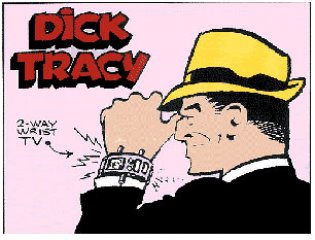 Was this a surprise? Hardly. Computers continue to become smaller. Google wants you to wear one on your head. How could anyone be surprised that Apple might be thinking more along the line of a Dick Tracy watch.
Was this a surprise? Hardly. Computers continue to become smaller. Google wants you to wear one on your head. How could anyone be surprised that Apple might be thinking more along the line of a Dick Tracy watch.
The trademark application was filed in June and would apply to computers, computer peripherals, and wristwatches. CEO Tim Cook told tech and media executives that wearable computer products are worth investigating, but he downplayed Google's Glass and other similar devices, including watches, as being a tough sell in the youth market.
The New York Times reported as early as February that Apple was considering a watch that would run on the same IOS platform as the Ipad and Iphones.
You may not remember when I made fun of the name "Ipad" a few years ago, but I do. This time, I'll just sit quietly.
Tech Sector Moves toward Sustainable Energy Sources
Apple says that it will build a solar farm to power its Reno data center. One computer doesn't use a lot of electricity, but hundreds or thousands of computers in data centers owned by Apple, Amazon, Google, and other big players use enormous amounts of power and the air conditioning systems designed to make computers happy can belch huge amounts of hot air into the environment.
New computer centers are being designed to use natural cooling when possible and now Apple has a plan to power one of its data centers with electricity generated from a solar panel farm in Nevada.
If solar power can be functional in often-cloudy Ohio, and I'm seeing more new homes being built with solar arrays on the roof, then it should certainly work in Nevada. Apple will build an 18-megawatt solar electric plant in northern Nevada. The facility will power a data center that will be located east of Reno.
Apple announced plans to build the data center last year and now NV Energy has filed forms with the Public Utilities Commission to construct the power plant. Approval could take several months.
Apple says that all of its data centers are powered entirely by renewable energy. This is the first phase of a solar power plant that will eventually cover nearly 140 acres and will generate more than 40 million kilowatt hours of renewable power.
What does that mean to the environment? For some reason, Apple didn't compare the impact to that caused by traditional power plants. Instead, the comparison was to vehicles: The new plant will reduce pollution each year by the amount of pollution created by almost 6500 cars and trucks.
The electric industry likes to position itself as a "clean" energy source even though the claims are easily disproved. Converting to solar and other renewable, non-polluting energy sources will begin to bring reality more in line with the electric industry's claims.
And in the process, it will improve the environment and add jobs to the economy. Nevada Governor Brian Sandoval says the project will bring hundreds of jobs to the county that has the highest unemployment rate in the state.

